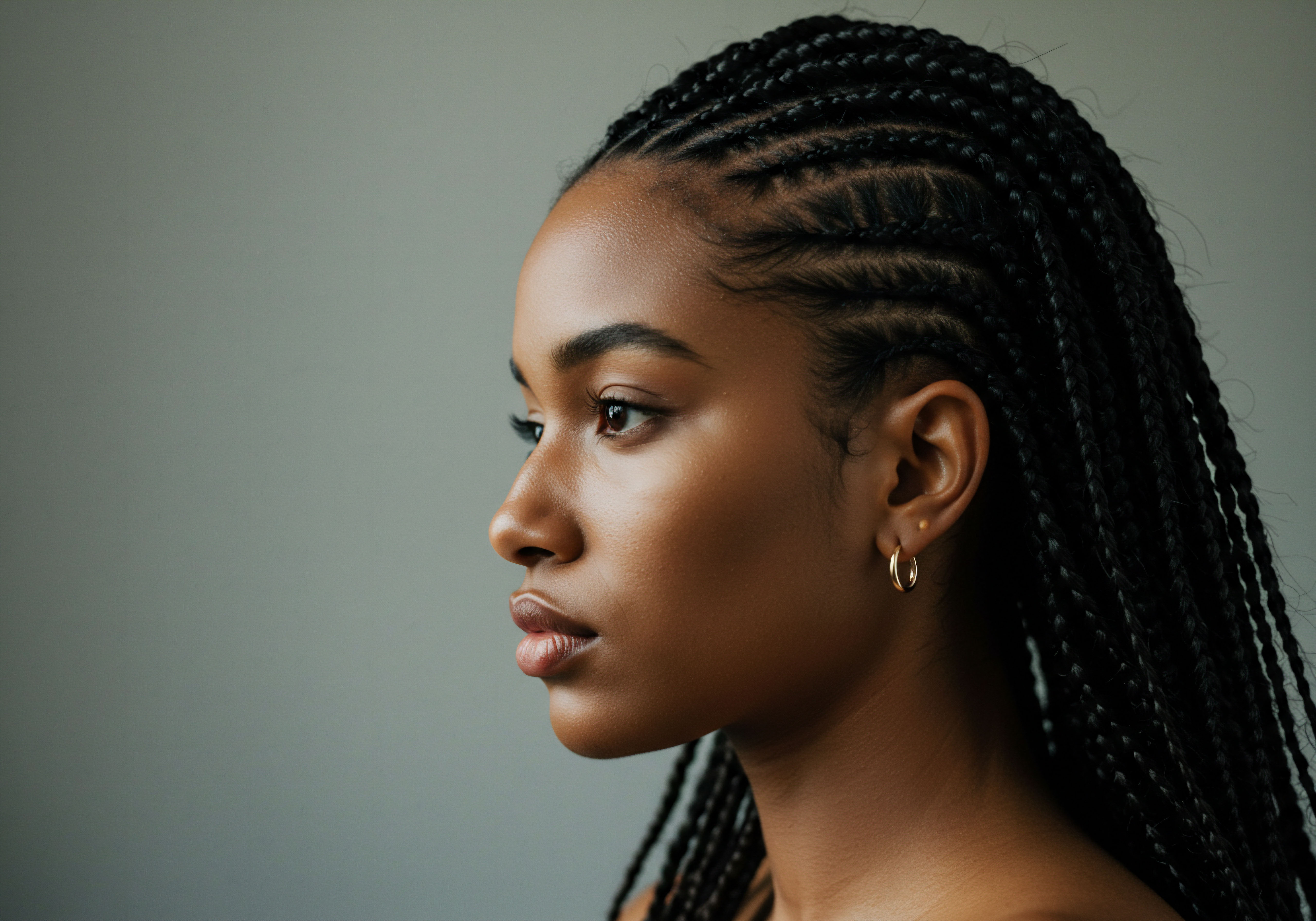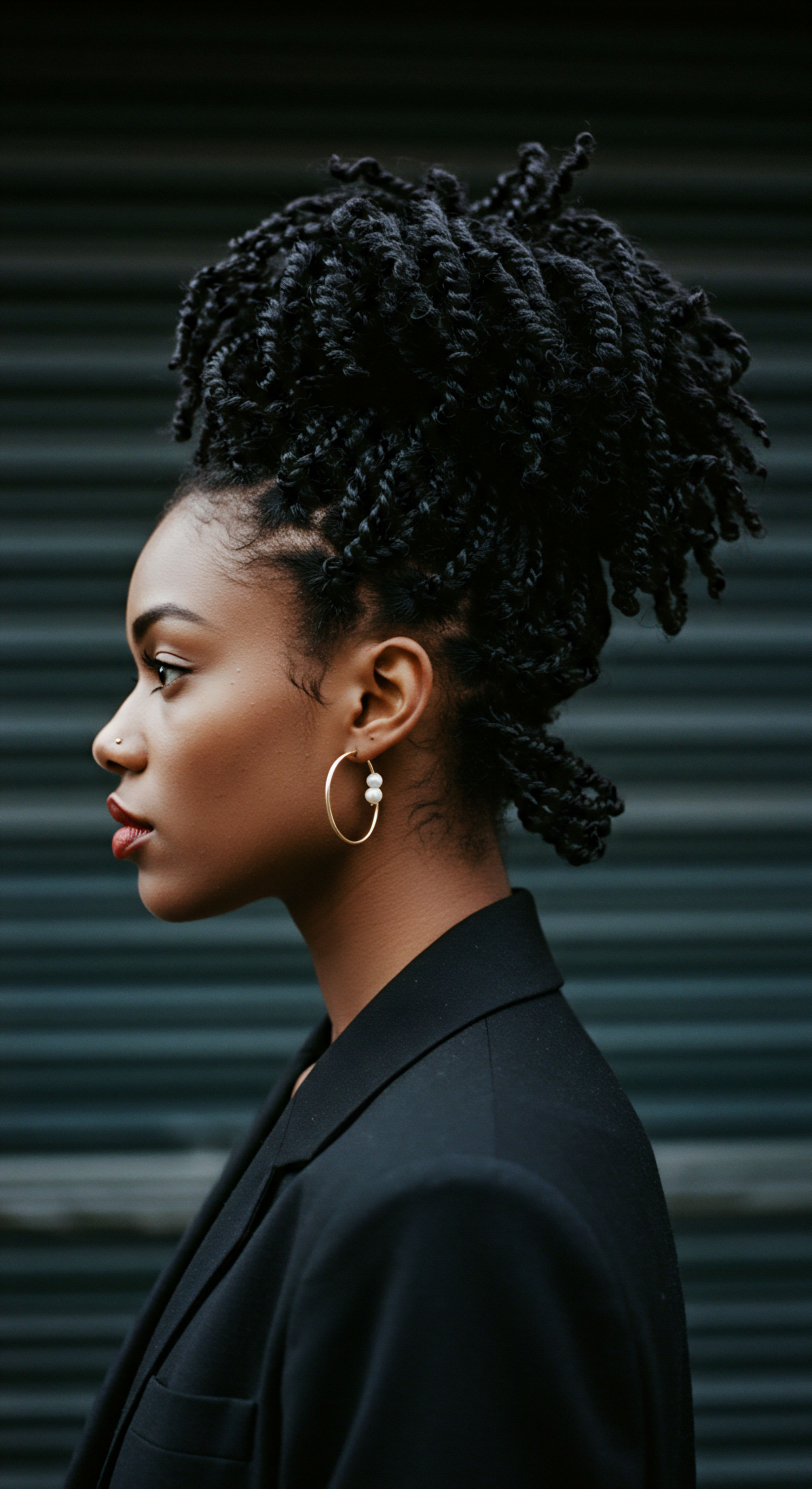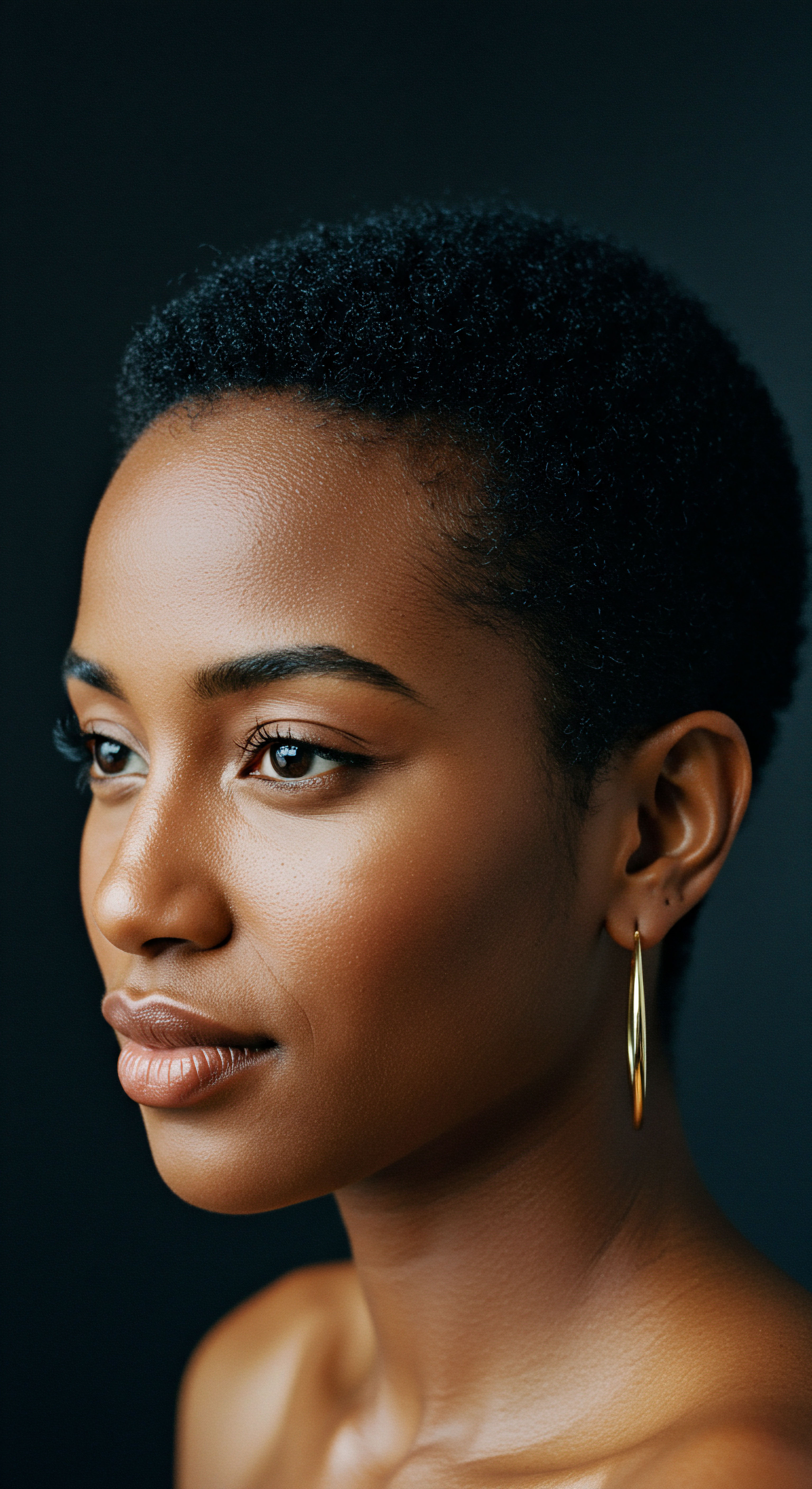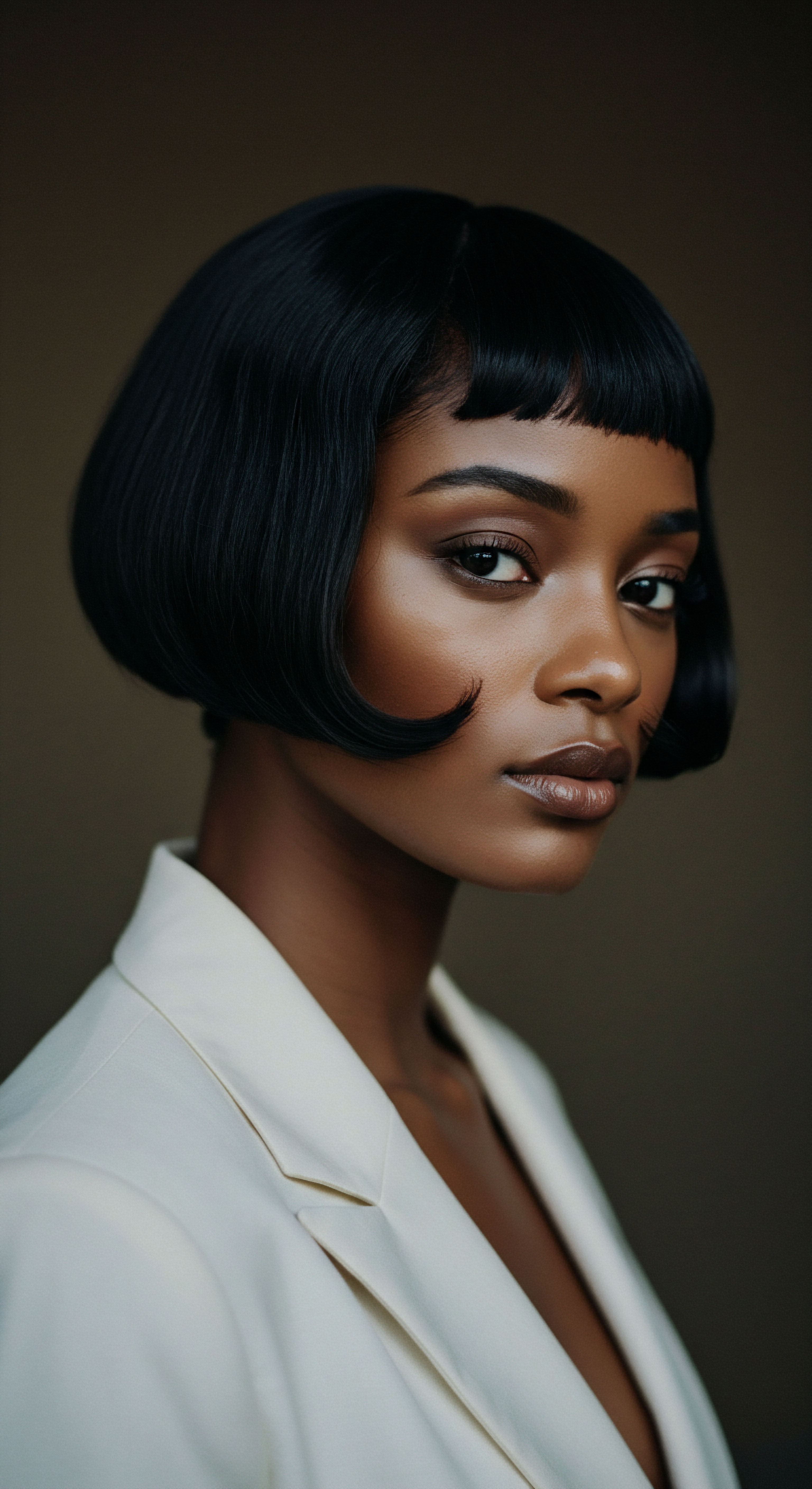
Roots
The whisper of ancient sands often carries secrets, not just of pharaohs and pyramids, but of daily rhythms, of beauty rituals practiced under a relentless sun. For those of us navigating the unique landscape of textured hair, a quiet wonder often stirs ❉ could the wisdom of antiquity, specifically the hair treatments of ancient Egypt, offer a guiding hand to our modern needs? This inquiry beckons us beyond fleeting trends, toward a foundational understanding of hair itself, inviting a deeper connection to the very fibers that crown us. It suggests that perhaps, within the elemental care of a civilization long past, there lies a profound simplicity that contemporary complex formulations sometimes overlook.

Understanding the Textured Strand
The intricate architecture of textured hair, whether a cascade of curls, a spring of coils, or a dense arrangement of kinks, possesses a distinct character. Each strand, emerging from its follicle, carries a unique blueprint. Unlike straight hair, which often presents a uniform cylindrical shape, textured hair exhibits an elliptical or even flattened cross-section. This structural variation influences how the cuticle layers, those protective scales that shield the inner cortex, lie.
In textured hair, these cuticles tend to lift more readily, creating a greater surface area for moisture to escape. This inherent characteristic explains why dryness often stands as a central concern for many with curls and coils. The natural bends and twists also serve as points of fragility, where mechanical stress can lead to breakage.
Consider the Cortex, the inner core of the hair strand, which holds the pigment and much of its strength. Surrounding this, the Cuticle acts as a shield. The manner in which these layers are arranged and the shape of the strand itself contribute to the hair’s overall porosity – its ability to absorb and retain moisture. A deeper comprehension of these elemental truths forms the bedrock for any effective hair care practice, whether rooted in ancient traditions or modern science.
The intrinsic architecture of textured hair, with its unique elliptical shape and lifted cuticle, often predisposes it to dryness and fragility.

The Language of Coils and Kinks
Describing textured hair often involves a rich vocabulary, a testament to its diversity. While various classification systems exist, such as the widely recognized numerical and alphabetical designations (e.g. 3A, 4C), they serve as helpful guides rather than rigid definitions. These systems attempt to categorize curl patterns based on their diameter and tightness.
For instance, a ‘3’ type typically indicates looser curls, while a ‘4’ type signifies tighter coils or kinks. The accompanying letter, A, B, or C, further refines the pattern’s intensity.
Beyond simple categorization, the true lexicon of textured hair speaks to its varied textures, its density, and its response to moisture. Understanding these distinctions allows for a more personalized approach to care. A hair type with a tighter curl pattern might experience greater shrinkage, for example, making length retention a different kind of challenge. Conversely, looser curls might require different approaches to maintain definition without being weighed down.
- Curl Pattern ❉ The shape the hair naturally forms, from loose waves to tight coils.
- Porosity ❉ The hair’s ability to absorb and hold moisture, influenced by cuticle health.
- Density ❉ The number of individual hair strands on the scalp, impacting overall volume.

Cycles of Growth, Echoes of Time
Hair, whether ancient or contemporary, moves through distinct growth phases. The Anagen Phase marks active growth, a period where hair cells rapidly divide, extending the strand. This can last for several years, varying from person to person.
Following this, the Catagen Phase is a brief transitional period where growth ceases and the hair follicle shrinks. Finally, the Telogen Phase is a resting period, after which the hair sheds, making way for new growth.
Ancient Egyptians, though without microscopes or modern scientific terminology, certainly observed these cycles. Their practices, from gentle handling to the application of nourishing balms, likely aimed to prolong the anagen phase and support the overall health of the scalp, recognizing it as the fertile ground from which hair springs. The meticulous care evident in tomb paintings and preserved artifacts hints at a profound respect for the hair’s life cycle, a wisdom that still holds merit today. Supporting the scalp, reducing breakage, and minimizing stress on the hair follicle all contribute to a healthier growth cycle, irrespective of the era.
| Phase Name Anagen |
| Description Active growth, cells divide rapidly. |
| Duration 2-7 years (variable) |
| Phase Name Catagen |
| Description Transitional phase, growth stops, follicle shrinks. |
| Duration 2-3 weeks |
| Phase Name Telogen |
| Description Resting phase, hair sheds. |
| Duration 2-4 months |

Ritual
Stepping from the fundamental truths of hair into the realm of practice, we find ourselves pondering the ‘how.’ How did ancient Egyptians, with their deep understanding of the natural world, translate their observations into effective hair care? This section considers the techniques, the materials, and the consistent applications that formed the heart of their hair rituals, offering a lens through which to view potential applications for modern textured hair types. It is here that the wisdom of daily dedication and purposeful action comes into sharp focus, guiding us toward tangible methods for care.

Protective Wraps and Plaits
The visual record of ancient Egypt abounds with depictions of elaborate hairstyles, from intricate braids to sophisticated wigs. These styles served not only aesthetic purposes but also functioned as powerful protective measures. Wigs, often crafted from human hair or plant fibers, provided a shield against the harsh desert environment, protecting the wearer’s natural hair from sun damage, dust, and excessive moisture loss. Similarly, the widespread practice of braiding and plaiting hair offered a method of minimizing tangling, reducing breakage, and maintaining moisture within the hair shaft.
For modern textured hair, protective styling remains a cornerstone of healthy hair practices. Styles such as braids, twists, cornrows, and buns mimic the ancient protective function, allowing the hair to rest from daily manipulation and environmental stressors. These styles help to retain length by reducing friction and preventing the delicate curl pattern from unraveling, which can lead to knots and breakage. The consistency of these practices across millennia speaks to their inherent effectiveness in preserving hair integrity.

The Art of Ancient Elixirs
Ancient Egyptian hair treatments were largely composed of natural ingredients, a testament to their deep connection with the surrounding flora and fauna. Archaeological and chemical analyses of mummified hair samples from the New Kingdom (c. 1550-1070 BCE) consistently reveal the presence of complex lipid mixtures, primarily animal fats combined with various plant oils such as Castor Oil and Moringa Oil, alongside traces of resins.
These preparations served not only as styling agents but also significantly contributed to the preservation of hair fibers over thousands of years, maintaining elasticity and preventing degradation. This longevity speaks volumes about the efficacy of these elemental, natural formulations in comparison to the transient effects of some modern synthetic concoctions.
Castor oil, a staple in ancient Egyptian beauty, is renowned today for its emollient properties and its purported ability to support hair growth. Moringa oil, derived from the “miracle tree,” was valued for its antioxidant content and its conditioning capabilities. These natural emollients would have provided a protective coating to the hair, sealing in moisture and imparting a lustrous sheen. The painstaking preparation of these balms, often involving grinding, heating, and mixing, speaks to a meticulous approach to hair wellness.
Ancient Egyptian balms, rich in natural oils and fats, provided exceptional conditioning and protection, enabling hair preservation across millennia.

Applying the Old to the New
The principles behind ancient Egyptian hair care offer practical avenues for modern textured hair regimens. The consistent application of nourishing oils and fats, for example, mirrors the contemporary practice of “sealing” moisture into the hair. After hydrating textured hair with water or a water-based product, a rich oil or butter can be applied to create a barrier, preventing the rapid evaporation of moisture. This method is particularly beneficial for high-porosity hair, where cuticles tend to remain open.
Similarly, the emphasis on protective styling resonates deeply with the needs of textured hair. Minimizing daily manipulation, opting for styles that tuck away the ends, and covering hair at night are all practices that find echoes in ancient Egyptian routines. The simplicity of their ingredients also encourages a closer look at our own product lists, prompting a consideration of whether a return to more elemental, naturally derived components could yield profound benefits for hair health.
- Oil Application ❉ Regularly apply natural oils like castor, moringa, or jojoba to seal moisture into strands.
- Protective Styles ❉ Incorporate braids, twists, or wraps to reduce daily manipulation and breakage.
- Gentle Handling ❉ Treat hair with care during cleansing and styling, avoiding harsh pulling.
| Ancient Practice Use of Plant Oils (Castor, Moringa) |
| Modern Textured Hair Benefit Deep conditioning, moisture retention, scalp nourishment. |
| Ancient Practice Protective Styling (Braids, Wigs) |
| Modern Textured Hair Benefit Reduced breakage, length retention, environmental protection. |
| Ancient Practice Consistent Balm Application |
| Modern Textured Hair Benefit Improved elasticity, cuticle smoothing, sustained hydration. |

Relay
Moving beyond the practical applications, a deeper consideration of ancient Egyptian hair care invites us to connect the visible aspects of hair health with broader cultural, scientific, and even psychological dimensions. The ‘Relay’ section extends our inquiry, seeking to understand the profound interconnectedness that defines true hair wellness, drawing upon scholarly insights and contemporary research to illuminate the enduring relevance of ancient practices. This is where the nuanced interplay of tradition, biology, and identity truly comes into focus.

Beyond the Surface The Holistic View of Hair Wellness
For ancient Egyptians, hair care was not merely a cosmetic endeavor; it was an integral part of personal hygiene, social status, and spiritual belief. The meticulous attention paid to hair, from childhood through adulthood, suggests a holistic understanding of well-being where external appearance mirrored internal vitality. This perspective contrasts sharply with a modern tendency to isolate hair issues from overall health.
A truly holistic approach to textured hair recognizes that its condition is influenced by a multitude of factors ❉ diet, hydration, stress levels, hormonal balance, and even sleep quality. The simple, pure ingredients used by ancient Egyptians, applied with consistent ritual, align with a philosophy that seeks to nourish the body as a whole. They understood that healthy hair begins from within, a concept that modern trichology increasingly affirms. The careful selection of ingredients, free from synthetic additives, minimized potential irritants, supporting a balanced scalp microbiome, which is a key component of hair health.

Science Meets Ancient Wisdom How Modern Trichology Validates Old Ways
Modern trichology, the specialized study of hair and scalp health, often provides scientific validation for ancient practices. The benefits of oils like castor and moringa, long utilized by Egyptians, are now supported by research demonstrating their emollient, anti-inflammatory, and antioxidant properties. For example, the high ricinoleic acid content in Castor Oil is known for its moisturizing capabilities and its potential to support a healthy scalp environment. Similarly, moringa oil is rich in fatty acids and vitamins, which contribute to hair conditioning and protection against environmental damage.
Consider the impact of physical manipulation on textured hair. Its unique structure makes it particularly vulnerable to breakage from harsh brushing or styling. The ancient Egyptian preference for protective styles and careful grooming, as evidenced by tomb artifacts and papyri, aligns with modern trichological recommendations to minimize mechanical stress on textured strands.
The careful unwrapping and re-styling of wigs, or the gentle re-braiding of natural hair, would have reduced the daily wear and tear that can lead to weakened fibers. This synergy between ancient observation and contemporary scientific understanding underscores the timeless efficacy of gentle, nourishing care.
A study published in the Journal of Ethnopharmacology, for instance, examined the traditional uses of various plant oils, including those historically used in ancient Egypt, and found significant scientific backing for their cosmetic and therapeutic properties, particularly their ability to hydrate, protect, and soothe the scalp. This research bridges the gap between anecdotal historical accounts and verifiable biological effects, demonstrating that ancient formulations were often remarkably effective due to their inherent chemical compositions.

Cultural Continuity and Hair Identity
Hair in ancient Egypt was deeply intertwined with identity, status, and cultural expression. The elaborate styles and treatments were not merely aesthetic choices; they conveyed messages about age, social standing, and even religious affiliation. This profound connection between hair and identity continues to resonate within textured hair communities today. For many, hair is a powerful symbol of heritage, resilience, and self-expression.
The cultural continuity of hair practices, passed down through generations, often retains echoes of ancient wisdom. The very act of caring for textured hair – the patient detangling, the careful application of oils, the styling into protective forms – can be a meditative, grounding experience, connecting individuals to a lineage of care that spans millennia. This ritualistic aspect, present in ancient Egypt, offers a sense of purpose and connection beyond superficial beauty standards.

A Modern Apothecary from Ancient Gardens
Translating ancient Egyptian hair care into a modern regimen involves a thoughtful selection of ingredients and a conscious approach to their application. The focus remains on pure, unrefined natural oils and plant extracts.
- Jojoba Oil ❉ Mimics the scalp’s natural sebum, making it an excellent conditioner and moisturizer.
- Argan Oil ❉ Rich in antioxidants and fatty acids, it helps improve hair elasticity and shine.
- Aloe Vera ❉ Known for its soothing and hydrating properties, beneficial for scalp health.
- Honey ❉ A natural humectant, drawing moisture from the air into the hair.
Creating a “modern apothecary” involves blending these ancient principles with contemporary understanding. This means prioritizing ingredients that are minimally processed, understanding their individual properties, and applying them with consistency and intention. It also calls for patience, recognizing that hair wellness is a continuous journey, not a destination achieved overnight.
| Ancient Ingredient Animal Fats (e.g. Ox Fat) |
| Traditional Use Emollient, protective barrier |
| Modern Textured Hair Application Shea butter, cocoa butter, rich plant-based balms for sealing. |
| Ancient Ingredient Castor Oil |
| Traditional Use Conditioning, promoting growth |
| Modern Textured Hair Application Scalp treatments, deep conditioning, strengthening. |
| Ancient Ingredient Moringa Oil |
| Traditional Use Antioxidant, nourishing |
| Modern Textured Hair Application Lightweight oils, leave-in conditioners, shine serums. |
| Ancient Ingredient Resins (e.g. Frankincense) |
| Traditional Use Styling, fragrance, preservation |
| Modern Textured Hair Application Styling gels with natural hold, aromatic hair mists. |
Modern trichology increasingly validates the efficacy of ancient Egyptian hair care, particularly the use of natural oils and protective styling.

Reflection
The journey through ancient Egyptian hair care reveals more than just historical facts; it uncovers a timeless wisdom that continues to resonate with the needs of modern textured hair. From the foundational understanding of the hair strand to the meticulous rituals of daily care and the profound cultural connections, the echoes of antiquity offer not a rigid prescription, but a gentle invitation. It suggests that simplicity, consistency, and a deep respect for natural processes hold enduring power.
Perhaps the greatest benefit offered by these ancient traditions lies not in replicating every historical detail, but in adopting their spirit ❉ a mindful, holistic approach to hair wellness that honors its unique character and its place within a broader sense of self and heritage. The ancient world, it seems, still has much to share about nurturing our crowning glory.

References
- Fletcher, Joann. Ancient Egyptian Hair ❉ A History of Adornment and Care. The American University in Cairo Press, 2016.
- D’Souza, L. J. & Kulkarni, R. V. (2018). “Ethnobotanical survey of medicinal plants used for hair care in traditional medicine.” Journal of Ethnopharmacology, 219, 178-189.
- Lucas, Alfred. Ancient Egyptian Materials and Industries. Dover Publications, 1999.
- Manniche, Lise. An Ancient Egyptian Herbal. University of Texas Press, 1989.
- Robins, Gay. Women in Ancient Egypt. Harvard University Press, 1993.
- Shaw, Ian. The Oxford History of Ancient Egypt. Oxford University Press, 2000.
- Nunn, John F. Ancient Egyptian Medicine. University of Oklahoma Press, 2002.
- Salloum, Habeeb, and Muna Salloum. The Arabian Nights Cookbook ❉ From Lamb Tagine to Harissa and from Sweet Pastries to Mint Tea. Tuttle Publishing, 2010.